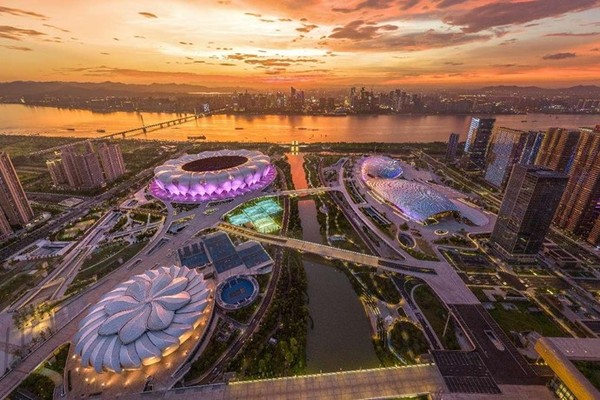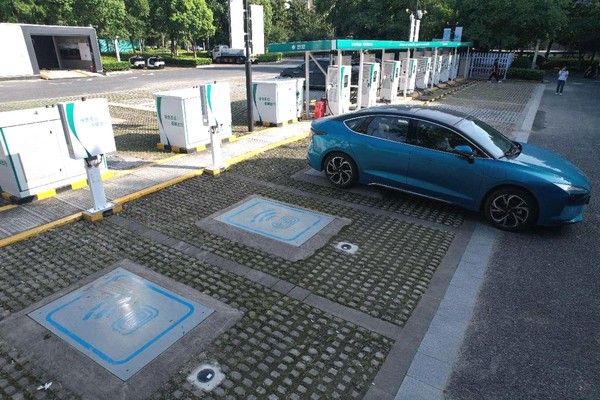By Li Zhongwen, Liu Junguo, People's Daily
Hangzhou city, capital of east China's Zhejiang province, is gearing up to make the 19th Asian Games, which is slated to run from Sept. 23 to Oct. 8 in the city, the first carbon-neutral Asian Games in history.
Determined to host a "Green, Smart, Economical and Ethical" Asian Games, Hangzhou has arranged for all 65 venues and office facilities for the event to run fully on green electricity from March through December this year.

The city has already completed transactions for 621 million kilowatt-hours (kWh) of green electricity for the event, bringing electricity produced from renewable energy sources thousands miles away to venues for the Hangzhou 2022 Asian Games through ultra-high voltage (UHV) grids.
(PV) power generation projects in areas along the ancient Silk Road, such as the Qaidam Basin in northwest China's Qinghai province, Jiayuguan city in northwest China's Gansu province, and the Loess Plateau in northern China, as well as wind power projects in places including Hami city in northwest China's Xinjiang Uygur autonomous region, have all contributed green power to the event.

In addition, green electricity produced by projects in Zhejiang province, including distributed PV power projects and offshore wind power projects, has also converged in the national grid, lighting up facilities of the upcoming Hangzhou Asian Games together with wind and solar power from regions along the ancient Silk Road.
It's worth noting that a single crystal double-sided PV module of a PV power generation project located in Hainan Tibetan autonomous prefecture, Qinghai province, can generate 2.2 kWh of electricity daily.

After being transmitted to Hangzhou through China's west-to-east power transmission program, this 2.2 kWh of green electricity can power a single energy-efficient light bulb at the gymnasium of Hangzhou Olympic Sports Center cluster, the main venue for the 19th Asian Games, for 220 hours.
Electric vehicles are expected to contribute to the formation of a new trend toward green travel during the Hangzhou Asian Games.
According to credible sources, the State Grid Hangzhou Power Supply Company is pressing ahead with the full coverage of charging piles at venues for the Hangzhou Asian Games, and is building a green travel service system in key areas related to the event, including Hangzhou's Xiaoshan district and Binjiang district, as well as their surrounding areas.
The company also endeavors to build a one-kilometer radius charging circle in areas related to the Hangzhou Asian Games by equipping the Hangzhou Asian Games village in Xiaoshan district with China's first high-power wireless charging station for new energy vehicles (NEVs) and building charging station at the Hangzhou Xiaoshan International Airport.
The company has built a cumulative total of 102 charging stations and 2,024 charging piles in the city, striving to provide all-round services for green travels during the Hangzhou Asian Games.
The concept of green and low-carbon development has been ingeniously integrated into the design and operations of competition venues for the Hangzhou Asian Games. Among the venues of the Hangzhou Olympic Sports Center cluster, a butterfly-shaped venue that incorporates a natatorium and a gymnasium has drawn great attention because of its novel appearance and eco-friendly design.
The venue is equipped with 210 light tubes, which diffuse natural light from the outdoors to the indoors through top skylight covers. Compared to fluorescent lights, these light tubes are flicker-free, environmentally friendly and energy-saving. They have a lifespan of up to 25 years, and can be turned on and off. More importantly, they can save approximately 100,000 kWh of electricity annually.
The roof of the Fuyang Water Sports Center, a venue for the Hangzhou 2022 Asian Games, has an area of approximately 24,000 square meters covered with soil. It is planted with green plants including Carthusian pink, common zinnia, and Chinese rose, blending in with the surrounding natural landscape.
These plants have not only increased the greening rate of the entire venue to 45 percent, but also benefited people by helping with carbon fixation and oxygen release, heat insulation, and stormwater runoff reduction.
Yangshan Sport Climbing Center, located in Keqiao district, Shaoxing city, Zhejiang province, is a venue for the Hangzhou Asian Games that has been transformed from an abandoned mine into an international competition venue and a youth rock climbing base.
The venue has adopted a semi-open design, allowing athletes and spectators to enjoy the natural scenery of the original quarry during competitions.
With a total construction area of 850,000 square meters, the Hangzhou International Expo Center in Xiaoshan district will serve as the main media center, the venue for squash competitions and training, as well as the official reception hotel for the Hangzhou Asian Games.
In order to reduce waste generation at the point of origin, the center, which used to generate 4,000 tonnes of various types of waste annually, has introduced an intelligent waste sorting system. The system provides real-time statistical analysis of the waste generated in the venue and hotel areas, and timely carries out harmless treatment, significantly minimizing the production of waste.
"Green" is one of the fundamental principles guiding the organization of the Hangzhou Asian Games, and "zero waste" is considered an important aspect of the "Green" Asian Games. By "zero waste", the organizers do not simply mean not generating solid waste, but aim to continuously promote waste reduction at the source and waste recycling, thus minimizing the impact of solid waste on the environment.
The concept of "zero waste" runs through every aspect of the preparation for the 19th Asian Games. Only 12 of the 56 venues for the event are newly built, and the remaining 44, which are transformed or temporarily constructed competition venues, have widely utilized prefabricated buildings and recyclable and renewable materials during construction.
The glass walls and spectator stands, among other facilities of the Squash Court of the Hangzhou Asian Games, for example, can be removed and transported as a whole after the competitions, and donated to relevant industries for the promotion and popularization of squash.
In many other aspects of the event, such as accommodation and catering, the Hangzhou Asian Games also endeavors to reduce solid waste generation at the source and boost recycling, maximizing utilization of resources.

